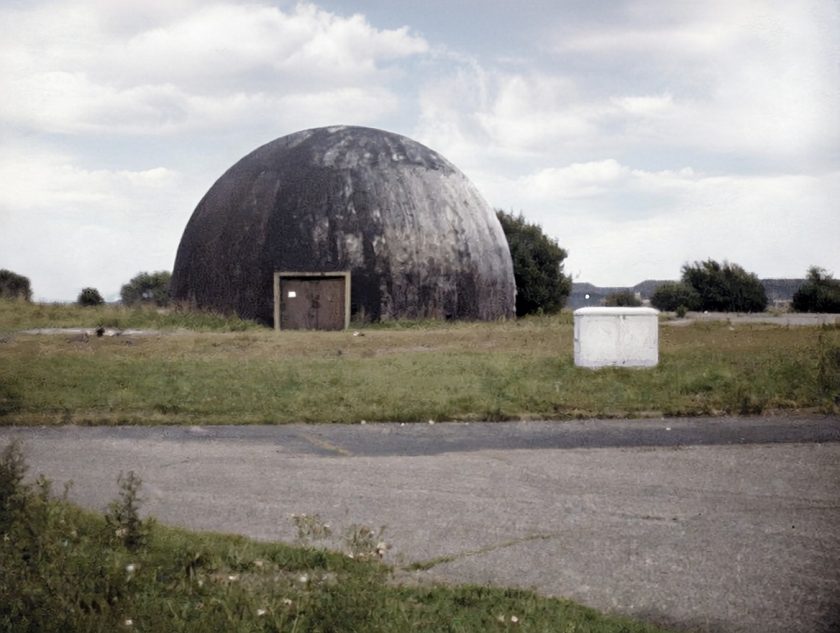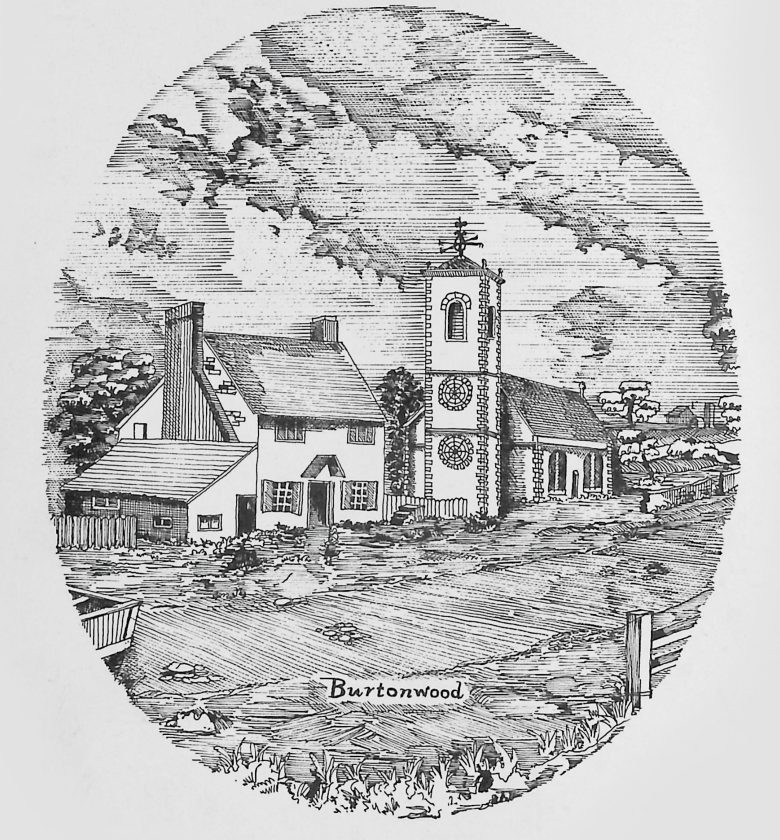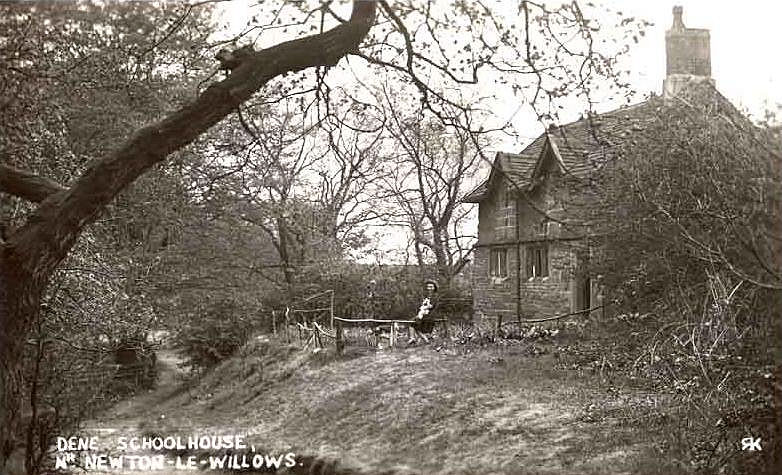The Chapel of Burtonwood was founded by Thos. Bold Esq., by a deed of feoffment, dated 27th, Sept. 1605. He conveyed a portion of land in trust from the Waste In Burtonwood, 40 roods In length and 20 roods In breadth. The rent charge to be one penny annually to him and his heirs on the Natal feast of St. John the Baptist.
It appears by the proceedings of a Commission AD.PIUS.VSUS. before John Bishop of Chester on an inquisition taken at Wigan March 28th, 1627
That Thomas Darbishire of Burtonwood Yeoman by his Will dated Jan 23rd, 44 Elizabeth 1558) had designed to found a Chapel at Windybanke in Burtonwood and for this purpose bequeathed to trustees (threescore pounds, £60) to purchase land or a rent charge for the maintenance of a Minister or Reader.
The Jurors of the above inquisition found that a Chapel or House of Prayer had existed there for 20 years or more according to the intent of the testator Thomas Darbishire.
Mr. Thomas Hindle was first Minister at Burtonwood. He was appointed in 1605, He died in l632, and was buried at Winwick on June l6th, l632. The Register at Winwick Chapel expressly describes him as the Minister of Burtonwood.
Mr. Edward Kenrick was reader at Burtonwood in l609.
Mr. Wm. Bagerley who succeeded to the Chapel at Burtonwood on the death of Mr. Thomas Hindle, he was elected by the inhabitants or major part of them.
On December 16th, 1634 the Chapel at Burtonwood was consecrated by the Right Revd: John Lord Bishop of Chester. Several notable people were present:-
Richard Bold Esq., of Bold. Thos Ireland Esq., of Bewsey, and diverse other inhabitants of Burtonwood.
Neither Bagerley nor any other name appears for the Ministery of Burtonwood in 1646 amongst the Lancashire classics. But in 1648 when Mr. Heyricks Harmonins Consent was signed, Mr. Wm. Bagerley signed it and described himself as Minister at Burtonwood.
Mr. Bagerley was soon removed by the independent party for signing the Harmoni Consent to make way for his successor. Mr. Bagerleys burial is recorded in the Warrington Church Register August 6th, 1652. a Mr. Jackson was schoolmaster at Burtonwood in 1648-50.
Mr. Samuel Mather Son of the Well known Richard Mather was Minister at Burtonwood. It is not known whether he was Mr. Bagerley’s Successor, but in 1660 he was officiating as the Minister at Burtonwood. In 1662 he went out under the Bartholomew Act. Entry in the Warrington Church Parish Register relates to Mr. Mather’s daughter, buried June 26th, 1662 – Martha the daughter of Mr. Samuel Mather Minister at Burtonwood.
Mr. John Chancy became the Minister at Burtonwood on 23rd, Jan 1676. He had a public disputation with the Quakers at Arley Hall Near Great Budworth. He wrote a work after this event (called) A skirmish with the Quakers, also a work called, A warning to Souls; both of which are mentioned in the Writings of Roger Haydock. Entry found in Dr Kendricks Warrington Worthies.
A certificate granted July 20th, 1690 at Ormskirk, That the House of Peter Gaskell be licensed as a meeting place for dissenting Protestants. Mr. John Heape is mentioned as Minister at Burtonwood in the year 1680. He was Minister at the passing of the Toleration Act, and probably also when the above Certificate was granted Licensing another place of Worship in Burtonwood.
Mr. Wm. Summer was the next Minister at Burtonwood. He was Minister about l694. He was Minister when a collection was made for distressed French Protestants driven from France by the Revocation of the Edict of Nantes 1685.
Mr. James Banks was next Minister at Burtonwood. According to the Terriers of Warrington Parish Church drawn up on July 22nd, 1712.
Mr. Robert Chapman the next Minister may not have been Mr. Bank’s successor. We have failed to find any record except that he resigned the living in 1757.
Mr. Kirby was next Minister at Burtonwood. He held the living until 1790.
Mr. James Cawley was the next Minister at Burtonwood. It is said he took the living for the love of the flock and not for their fleece. He came of a respectable family at Dallam in Burtonwood. He held the living until 1808.
Mr. Robt. Barlow succeeded Mr. Cawley in 1808 and became Minister at Burtonwood. He resigned the Chapel and the School in 1822. He died 23rd, Jan. 1823.
Mr. John Williamson succeeded Mr. Barlow both in the living of Burtonwood Chapel and the school. He was reprimanded for his conduct in 1828 for the neglect of the school. He died in 1828 at Southport where he had resided for some time.
Mr. Wm. Garnett Thomas was Mr. Williamson’s successor, and in 1829 accepted the living at Burtonwood and came to reside in the Parish. He was a native of the West Indies and served the cure at Burtonwood for 45 years. He resigned the living in 1874. He died at Burtonwood about Aug 2nd, 1879 aged 85 years.
Mr. Wm. Wilson was appointed Vicar of Burtonwood in 1876, he held the living until 1891.
The Revd. A.M. Mitchell was appointed Minister of Burtonwood in 1891. He died on Feb 18th, 1936 and was interred in Burtonwood Cemetery.
The Revd: Thos Cowing was appointed Vicar on June 5th, 1936 and is still the Vicar of Burtonwood.
——-
Gaskell trust deed held farm on left hand side of chapel lane, almost opposite cemetery & farm adjoining old vicarage where new one about to be built August 1962.
re: BURTONWOOD LAND EXTRACTS from Deeds and Abstracts of Title
The land appears to have belonged in 1722 to a Richard Atherton Esq, the heir of John Atherton, and Elizabeth his Wife and to have been conveyed by them to John Pritchard and James Penketh. The conveyancing is in the form of a fine recovery and it seems that Mr Atherton retained some interest in the land as it afterwards passed under his Will. It afterwards came into the possession of Roger Gwilliam and Elizabeth his Wife who mortgaged the land to Peter Bold (probably pone of the last survivors of the old Bold family) in 1743.
In 1765 the land appears to have come into the possession of Thomas Starkey and Thomas Grimshaw and in 1796 was in the possession of the Bold family from whom Lord Lilford appears to have acquired the property.
In 1814 the property was conveyed by Lord and Lady Lilford and their Trustees to the Rev. R. A. Rawsthorne in trust for the Rev. Robert Atherton Rawsthorne, and in 1817 the property was conveyed by the Rev. Robert Atherton Rawsthorne to Matthew Gaskell and his Trustee.
Matthew Gaskell appears to have left the property to his daughters and the property remained in the Gaskell family until 1919, a period of over 100 years, when it was sold to Mr H.E. Hulme, in whose possession it still is.
It seems that the families of the Bolds, the Athertons and the Rawsthornes are in some way connected, but the connection is not clear.
Richard Atherton by his Will dated 19th December 1722 directed his executors to lay out the sum of £100 in repairing Sankey Chapel and £200 more for obtaining Queen Anne’s Bounty to it and £50 to the Scholars of Brasenose College, Oxford, for beautifying the College and erecting some additional buildings thereto..
This has been transcribed from my photos of original documents in Chester Records Office, Thankyou to Andrew Fackey for help in the transcribing.



